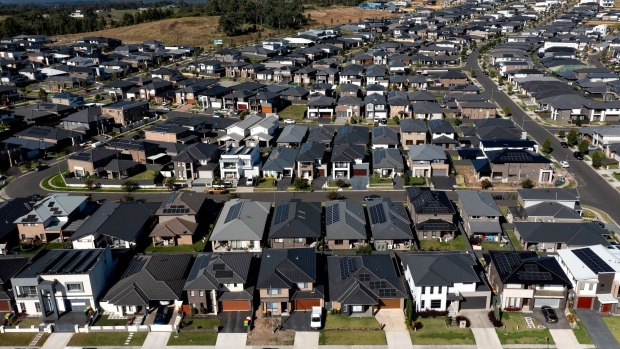Oct 2, 2022
Australian House Prices Drop as Steep RBA Rate Hikes Sour Demand
, Bloomberg News

(Bloomberg) --
Sydney home prices fell for an eighth straight month in September, pulling nationwide property values lower as rising interest rates sour demand.
The pace of declines eased after prices dropped in August by the most in four decades, according to CoreLogic, though the company’s research director Tim Lawless said it may be too early to predict the worst of the downturn is over.
Sydney, Australia’s largest market and its bellwether, saw prices slide 1.8%, CoreLogic Inc. said in a report Monday. Melbourne dropped 1.1% and Brisbane fell 1.7%. They were the main drivers behind a 1.4% decline in major cities. The national index, which includes regional markets, dropped 1.4%, though that was a smaller decline than the 1.6% recorded in August.
The Reserve Bank of Australia is widely expected to raise rates by 50 basis points this week to 2.85% -- a level not seen since April 2013. That is likely to add more pressure on an already weakening property market.
The RBA has so far hiked by a total of 225 basis points since May and is widely expected to take the cash rate to above 3% in coming months.
“It’s possible we have seen the initial shock of a rapid rise in interest rates pass through the market and most borrowers and prospective home buyers have now ‘priced in’ further rate hikes,” Lawless said. “However, if interest rates continue to rise as rapidly as they have since May, we could see the rate of decline in housing values accelerate once again.”
RBA officials have signaled confidence in mortgage holders’ ability to absorb rising borrowing costs, saying households are in a “fairly good position” to cope with them.
Lawless noted that the reduction in the pace of price declines -- Sydney’s house prices dropped 2.3% in August -- came alongside other signs of improvement, with auction clearance rates and consumer sentiment edging higher.
There’s plenty of scope for the economy to withstand the pressure of RBA hikes.
“RBA data suggest that even with a 20% national price decline the share of loans in negative equity would be modest (~2.5%), allaying much of the financial stability concerns, at least at this early stage of the cycle,” said Chris Read, Australia economist for Morgan Stanley.
Read recently upgraded his forecast for the RBA’s cash rate to 2.85% on Oct. 4 from 2.60% previously. The central bank will publish its half-year financial stability report on Friday.
Sign up for the New Economy Daily newsletter, follow us @economics and subscribe to our podcast.
©2022 Bloomberg L.P.





